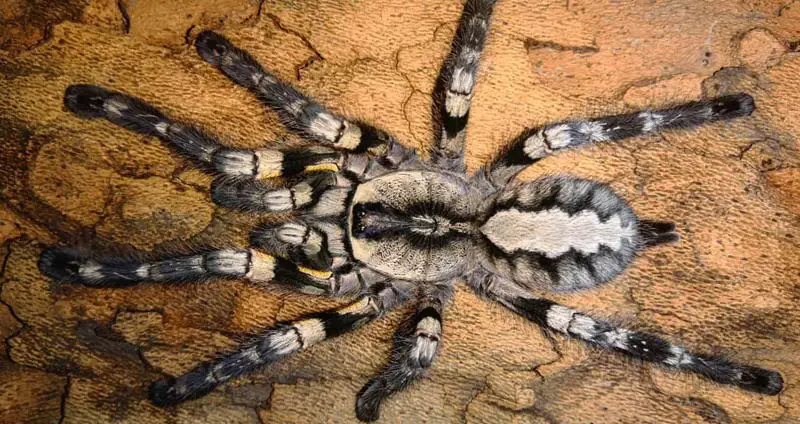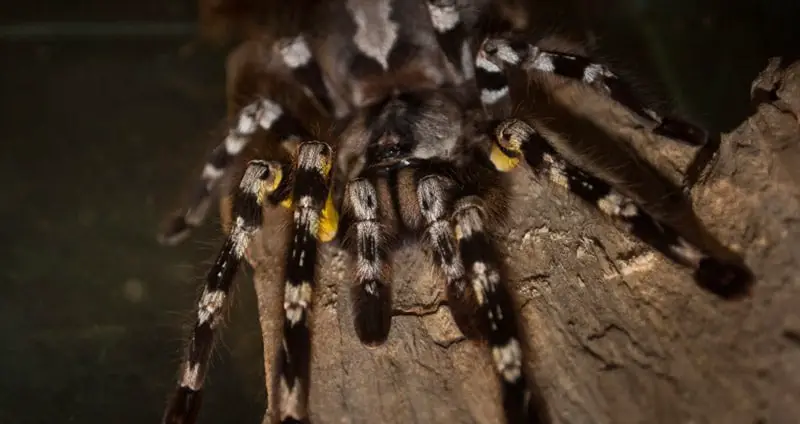With the widespread popularity and impressive diversity of tarantulas, its expected that some species will become more popular than others. The Indian Ornamental Tarantula (Poecilotheria regalis) has been a favorite among tarantula keepers for years and is considered one of the most beautiful species.
If you’re looking into adding an Indian Ornamental into your collection, there are a few things that you should know about this fascinating species. This post will review the unique appearance, interesting personality, and specific dietary and environmental needs of the Poecilotheria regalis.
Table of Contents
Poecilotheria regalis Care Sheet
| | |
Common Name |
Indian Ornamental |
Species Type |
Old world arboreal |
Natural Habitat |
Found in India, typically between the Eastern and Western Ghats. They live in trees and experience massive fluctuations in both temperature and humidity year-round. |
Growth Rate |
Medium-to-fast growth rate. Females and males can reach full size within a couple of years. |
Adult Size |
Females reach a legspan of between 6″ and 7″, with males measuring slightly smaller. |
Lifespan |
Females can live upwards of 20 years, while males often only live to 4 years. |
Enclosure |
The enclosure should be very large with a substantial amount of height to it. There should be about 2 inches of substrate on the bottom, and it should be decorated with a hide and fake plants/leaves. A water bowl should also be present. |
Temp/Humidity |
76°F to 78°F with about 70% to 80% humidity. |
Diet |
Great eater that can eat several adult-sized crickets per week. Dubia roaches and mealworms should be used as supplemental food. |
Temperament |
Not the most aggressive tarantula, but definitely isn’t scared to fend for itself. If threatened, it will throw up a threat pose, and it has a very painful bite to back up its threat. In fact, it possesses some of the most potent venom. |
Experience Level |
Advanced – While it isn’t the most difficult tarantula species to care for, its temperament is not easy for inexperienced keepers to deal with. It could pose quite a threat to beginners. |
Average Cost |
Slings ~ $50, Males ~ $75, Females ~ $100+ |
Poecilotheria regalis Appearance
The Indian Ornamental tarantula is a fascinating-looking species that makes it a favorite addition to many collections. Throughout the body of a Poecilotheria regalis, they feature impressive silver-grey fur that’s interrupted by darker stripes, spots, and other patterns, especially on their abdomen.
Two characteristics really set this species apart, though. First of all, the undersides of the front legs are a rich banana yellow that can be spotted from quite a distance away. Additionally, a brownish-red stripe is located underneath the abdomen — something that sets the Poecilotheria regalis apart from the other species in the genus.
Poecilotheria regalis tends to grow to an average size; about 6-7 inches in legspan when fully grown. Even the spiderlings grow quite quickly and develop the characteristics that unmistakably make them Indian Ornamentals. This quick and substantial growth must be taken into consideration when housing Poecilotheria regalis, and this will be covered in an upcoming section.


via @alireza.zamani.spider / Instagram
Poecilotheria regalis Temperament & Behavior
Indian Ornamental tarantulas are not known for their calm, docile demeanor. Instead, it should be noted that this is not a tarantula species that’s suitable for even occasional handling. Their quick movements make their actions difficult to predict, potentially resulting in them harming themselves or you.
While this is a tarantula species that’s much more prone to flee than put up a fight, you don’t want to take your chances. As they are an old world tarantula, they tend to have a shorter temper and a more painful bite.
In fact, Poecilotheria regalis is known to possess some of the most potent venom in a tarantula. Bite victims report persistent cramping to moderate swelling and pain for several days after the bite. Because of this, handling can never be recommended!
Despite that, when kept in a proper enclosure and left alone, this species tends to keep to themselves. Being that they are arboreal tarantulas, they often will hang out on the side of their enclosure hidden by bark, shrubs, or their own webbing. They do also enjoy being on the ground at times, though, so that will need to be taken into consideration when crafting their enclosure.
One more thing to note about Indian Ornamental tarantulas is that they are a colony species, meaning that they can potentially live in a community together if enough food is present. This still isn’t encouraged, though, as territory battles can occur. Each Poecilotheria regalis should have their own enclosure so that you can meet each of their needs individually.
Housing An Indian Ornamental Tarantula
If you’re thinking about bringing home a Poecilotheria regalis, you need to make sure that you’ll be able to meet their environmental needs. A tarantula setup doesn’t cost a lot of money initially, but it does need to have certain components.
As the name suggests, this tarantula is naturally found in India, typically between the Eastern and Western Ghats. They’re primarily arboreal tarantulas live within the trees and endure a diverse range of environmental conditions.
Optimal Enclosure
While Indian Ornamental tarantulas have specific needs for their enclosure, those needs aren’t hard to meet. To begin with, these are arboreal tarantulas, so their enclosure should focus more on height than floor space.
Poecilotheria regalis also doesn’t grow to be much larger than average, so they don’t need special-sized enclosures. Exo Terra’s “mini tall” terrarium is 12″x12″x18″ and will provide enough space for a fully-grown Indian Ornamental to thrive. You could also opt for a slightly bigger terrarium.
This particular terrarium is tall enough to allow Indian Ornamentals to construct webs toward the top, and the side opening allows you to keep this webbing intact.
Inside the terrarium, you need to add about 1-2 inches of moisture-retaining substrate, moss, a small water bowl, and some safe logs, sticks, and plants. A dedicated hide is also an essential aspect of their enclosure. You’re essentially trying to make the enclosure as close to a “tree environment” as possible.
Remember that it’s possible for Indian Ornamentals to be kept together, but it generally isn’t worth the risk of them becoming territorial. Therefore, they should be fine when kept in a temporary holding tank together, but anything more than that should typically be avoided.
Heating The Enclosure
In the forest climates of India, Poecilotheria regalis experiences a diverse array of different temperatures ranging from 46°F to over 100°F. This has resulted in quite a hardy species of tarantula. However, despite the fact that they can survive extreme temperatures, that doesn’t mean that they should.
It’s recommended that you keep your Indian Ornamental’s enclosure around 76°F to 78°F. Fortunately, this is right around room temperature for a lot of people, so additional heating may not be necessary in some households.
If your home ever does dip below 75°F, though, you’ll have to resort to supplemental heating. The most commonly-used method of heating for tarantulas is a space heater. This is used to gently warm the entire room that a tarantula is kept in and is very safe.
Additionally, Poecilotheria regalis need to live in a humidity of between 70% and 80% to mimic their natural humidity. Fortunately this is quite easy to maintain by dampening their substrate and moss with a spray bottle every couple of days. Be sure to monitor humidity and temperature levels regularly to make adjustments as needed.
Poecilotheria regalis Diet
While these tarantulas are described as fast-growing, they can only achieve this if they’re given a healthy diet. Tarantulas can’t be overfed, so it’s always a good idea to provide too much food than too little food. A healthy Indian Ornamental can eat almost daily, so don’t get concerned if yours is wolfing down food.
The Poecilotheria genus has a wild diet that’s defined mostly by termites, beetles, grasshoppers, and moths. This doesn’t need to be exactly what they’re fed, though. The most commonly-fed food to this species are crickets, roaches, and even locusts.
It’s recommended that keepers vary the food that their Poecilotheria regalis is getting to help supply them with a diverse array of different nutrients. Larger specimens can also be given pinky mice as a rare treat, which is messy but definitely appreciated by the tarantula.
When it comes time for your Poecilotheria regalis to molt, their feeding schedule will start to change. When you notice your tarantula not eating anymore, remove all food from their cage and let the molting process begin.
Indian Ornamentals like to hide in inaccessible areas in their enclosure to molt, so this is more of a waiting game on the keeper’s end. About a week or two after molting completes is when you can start feeding again.
Health Issues
If you ensure that your Indian Ornamental’s enclosure is optimal and that they’re eating a correct diet, they shouldn’t experience any health issues in their lifetime. Captive tarantulas suffer from very few issues aside from mites/parasites and dehydration, and both of those problems are quite simple to deal with.
The most common issue that Indian Ornamental owners may encounter is in the molting of their tarantula. It’s more difficult to identify a molt in this species than others as Poecilotheria regalis prefer to hide inside of their cork tube to molt.
If you notice that your tarantula has stopped eating and has suddenly disappeared, most of the time they’ve simply begun molting.
While most molts go off without a hitch, some may run into problems. In this case, the owner may have to physically help the tarantula remove its exoskeleton, which is necessary but dangerous. Fortunately, there are many guides available that help tarantula owners fix a bad molt.
Purchasing Poecilotheria regalis
Indian Ornamental Tarantulas aren’t the most accessible tarantulas tarantulas today, but they’re still quite easy to come by. As they are more aggressive and not beginner-friendly, they appeal to a smaller crowd, thus keeping their demand below something more friendly like a Pink Toe tarantula. Fortunately, there are still breeders all over the world that breed and sell this fascinating species.
Popular marketplaces like Underground Reptiles and Backwater Reptiles both have healthy specimens available for a low price. You’ll typically find younger Poecilotheria regalis specimens selling between $40 and $50 including a safe arrival and good health guarantee.
This low price for such a fascinating and beautiful tarantula species has helped the Indian Ornamental become admired by tons of tarantula enthusiasts around the world. They may be more “for show” than other species, but for such a small amount of money they’re still a great addition to any collection.

